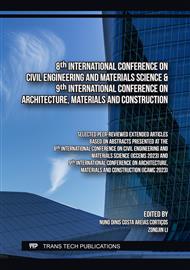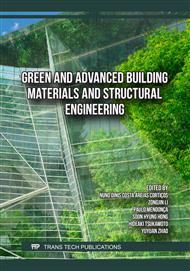[1]
M. Bassani, L. Tefa, A. Russo, P. Palmero, Alkali-activation of recycled construction and demolition waste aggregate with no added binder, Constr Build Mater. 205 (2019) 398–413.
DOI: 10.1016/j.conbuildmat.2019.02.031
Google Scholar
[2]
R. v. Silva, J. de Brito, R.K. Dhir, Use of recycled aggregates arising from construction and demolition waste in new construction applications, J Clean Prod. 236 (2019) 117629.
DOI: 10.1016/j.jclepro.2019.117629
Google Scholar
[3]
J.R. Jiménez, J. Ayuso, F. Agrela, M. López, A.P. Galvín, Utilisation of unbound recycled aggregates from selected CDW in unpaved rural roads, Resour Conserv Recycl. 58 (2012) 88–97.
DOI: 10.1016/j.resconrec.2011.10.012
Google Scholar
[4]
F. Agrela, A. Barbudo, A. Ramírez, J. Ayuso, M.D. Carvajal, J.R. Jiménez, Construction of road sections using mixed recycled aggregates treated with cement in Malaga, Spain, Resour Conserv Recycl. 58 (2012) 98–106.
DOI: 10.1016/j.resconrec.2011.11.003
Google Scholar
[5]
Y.D. and J. de B. F. Pacheco-Torgal, V. W. Y. Tam, J. A. Labrincha, Handbook of recycled concrete and demolition waste, Woodhead Publishing Series in Civil and Structural Engineering, Cambridge, UK, 2013.
DOI: 10.1533/9780857096906
Google Scholar
[6]
M. de Schepper, K. de Buysser, I. van Driessche, N. de Belie, The regeneration of cement out of Completely Recyclable Concrete: Clinker production evaluation, Constr Build Mater. 38 (2013) 1001–1009.
DOI: 10.1016/j.conbuildmat.2012.09.061
Google Scholar
[7]
C. Diliberto, A. Lecomte, J.M. Mechling, L. Izoret, A. Smith, Valorisation of recycled concrete sands in cement raw meal for cement production, Materials and Structures/Materiaux et Constructions. 50 (2017) 1–12.
DOI: 10.1617/s11527-017-0996-8
Google Scholar
[8]
D. Gastaldi, F. Canonico, L. Capelli, L. Buzzi, E. Boccaleri, S. Irico, An investigation on the recycling of hydrated cement from concrete demolition waste, Cem Concr Compos. 61 (2015) 29–35.
DOI: 10.1016/j.cemconcomp.2015.04.010
Google Scholar
[9]
J. Schoon, K. de Buysser, I. van Driessche, N. de Belie, Fines extracted from recycled concrete as alternative raw material for Portland cement clinker production, Cem Concr Compos. 58 (2015) 70–80.
DOI: 10.1016/j.cemconcomp.2015.01.003
Google Scholar
[10]
Y. Liu, C. Yang, F. Wang, S. Hu, M. Zhu, C. Hu, L. Lu, Evaluation on recycled clinker production and properties from regeneration of completely recycle concrete, Constr Build Mater. 301 (2021) 123882.
DOI: 10.1016/j.conbuildmat.2021.123882
Google Scholar
[11]
Z. Shui, J. Lu, S. Tian, P. Shen, S. Ding, Preparation of new cementitious system using fly ash and dehydrated autoclaved aerated concrete, Journal Wuhan University of Technology, Materials Science Edition. 29 (2014) 726–732.
DOI: 10.1007/s11595-014-0987-3
Google Scholar
[12]
M.V.A. Florea, Z. Ning, H.J.H. Brouwers, Activation of liberated concrete fines and their application in mortars, Constr Build Mater. 50 (2014) 1–12.
DOI: 10.1016/j.conbuildmat.2013.09.012
Google Scholar
[13]
K. Kalinowska-Wichrowska, E. Pawluczuk, M. Bołtryk, Waste-free technology for recycling concrete rubble, Constr Build Mater. 234 (2020) 117407.
DOI: 10.1016/j.conbuildmat.2019.117407
Google Scholar
[14]
J.A. Bogas, A. Carriço, M.F.C. Pereira, Mechanical characterization of thermal activated low-carbon recycled cement mortars, J Clean Prod. 218 (2019) 377–389.
DOI: 10.1016/j.jclepro.2019.01.325
Google Scholar
[15]
C.S. Poon, S. Azhar, M. Anson, Y.L. Wong, Strength and durability recovery of fire-damaged concrete after post-fire-curing, Cem Concr Res. 31 (2001) 1307–1318.
DOI: 10.1016/s0008-8846(01)00582-8
Google Scholar
[16]
R. Serpell, M. Lopez, Properties of mortars produced with reactivated cementitious materials, Cem Concr Compos. 64 (2015) 16–26.
DOI: 10.1016/j.cemconcomp.2015.08.003
Google Scholar
[17]
R. Serpell, F. Zunino, Recycling of hydrated cement pastes by synthesis of α'H-C2S, Cem Concr Res. 100 (2017) 398–412.
DOI: 10.1016/j.cemconres.2017.08.001
Google Scholar
[18]
S. Real, A. Carriço, J.A. Bogas, M. Guedes, Influence of the treatment temperature on the microstructure and hydration behavior of thermoactivated recycled cement, Materials. 13 (2020).
DOI: 10.3390/ma13183937
Google Scholar
[19]
S. Zhutovsky, A. Shishkin, Recycling of hydrated Portland cement paste into new clinker, Constr Build Mater. 280 (2021) 122510.
DOI: 10.1016/j.conbuildmat.2021.122510
Google Scholar
[20]
L. Lu, S. Yu, Y. He, S. Hu, Dehydration process of calcium silicate hydrate during heating in the air, Adv Mat Res. 287–290 (2011) 785–788.
DOI: 10.4028/www.scientific.net/amr.287-290.785
Google Scholar
[21]
C. Alonso, L. Fernandez, Dehydration and rehydration processes of cement paste exposed to high temperature environments, J Mater Sci. 39 (2004) 3015–3024.
DOI: 10.1023/b:jmsc.0000025827.65956.18
Google Scholar
[22]
Y. Okada, K. Sasaki, H. Ishida, T. Mitsuda, Formation Processes of β-C2S by the Decomposition of Hydrothermally Prepared C-S-H with Ca(OH)2, Journal of the American Ceramic Society. 77 (1994) 1319–1323.
DOI: 10.1111/j.1151-2916.1994.tb05409.x
Google Scholar
[23]
K. Morsli, Á.G. de la Torre, M. Zahir, M.A.G. Aranda, Mineralogical phase analysis of alkali and sulfate bearing belite rich laboratory clinkers, Cem Concr Res. 37 (2007) 639–646.
DOI: 10.1016/j.cemconres.2007.01.012
Google Scholar



